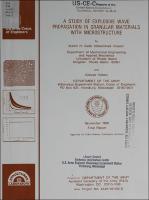Please use this identifier to cite or link to this item:
https://hdl.handle.net/11681/11296Full metadata record
| DC Field | Value | Language |
|---|---|---|
| dc.contributor | University of Rhode Island. Department of Mechanical Engineering | - |
| dc.contributor | United States. Assistant Secretary of the Army (R & D) | - |
| dc.contributor.author | Sadd, Martin H. (Martin Howard) | - |
| dc.contributor.author | Hossain, Mohammad | - |
| dc.contributor.author | Rohani, Behzad | - |
| dc.date.accessioned | 2016-06-20T14:17:13Z | - |
| dc.date.available | 2016-06-20T14:17:13Z | - |
| dc.date.issued | 1986-09 | - |
| dc.identifier.uri | http://hdl.handle.net/11681/11296 | - |
| dc.description | Technical Report | - |
| dc.description | Abstract: This report describes an investigation into one-dimensional stress wave propagation in granular materials with microstructure. The study employs the distributed body concept advanced by Goodman and Cowin and the associated wave propagation studies conducted by Nunziato, Walsh, et al. A one-dimensional computer program, referred to as MIC1D, has been developed for studying wave propagation in granular materials due to airblast loading. The computer program allows for (1.) arbitrary surface airblast loading, (2.) depth-dependent volume distribution function simulating gravity effects in a granular mass, and (3.) treatment of grain size and local porosity as random variables. Three foms of depth-dependent volume distribution functions are incorporated in the program, i.e. a periodic fom, an exponential fom, and a combined periodic-exponential fomulation. The user can select any of these forms for the particular application at hand. The probabilistic treatment of grain size and local porosity is accomplished by using a moment-generating procedure due to Rosenblueth. The computer program calculates the expected value and the variance of the output quantities, such as stress and particle motion, due to the randomness in these variables. Application of the computer program is demonstrated by presenting the results of a series of parametric calculations dealing with propagation of acceleration waves in granular media. A documentation of MIC1D is provided in Appendix A. | - |
| dc.publisher | Structures Laboratory (U.S.) | - |
| dc.publisher | Engineer Research and Development Center (U.S.) | - |
| dc.relation | http://acwc.sdp.sirsi.net/client/en_US/search/asset/1035585 | - |
| dc.relation.ispartofseries | Technical report (U.S. Army Engineer Waterways Experiment Station) ; SL-86-35. | - |
| dc.rights | Approved for public release; distribution is unlimited. | - |
| dc.source | This Digital Resource was created from scans of the Print Resource | - |
| dc.subject | Airblast loading | - |
| dc.subject | Probabilistic analyses | - |
| dc.subject | Constitutive relationship | - |
| dc.subject | Microstructural model | - |
| dc.subject | Granular material | - |
| dc.subject | Wave propagation | - |
| dc.subject | Shock waves | - |
| dc.subject | Micromechanics | - |
| dc.subject | Wave mechanics | - |
| dc.subject | Blast effects | - |
| dc.subject | Explosion effects | - |
| dc.subject | Computer programs | - |
| dc.subject | MIC1D | - |
| dc.title | A study of explosive wave propagation in granular materials with microstructure | - |
| dc.type | Report | en_US |
| Appears in Collections: | Technical Report | |
Files in This Item:
| File | Description | Size | Format | |
|---|---|---|---|---|
| TR-SL-86-35.pdf | 17.12 MB | Adobe PDF |  View/Open |